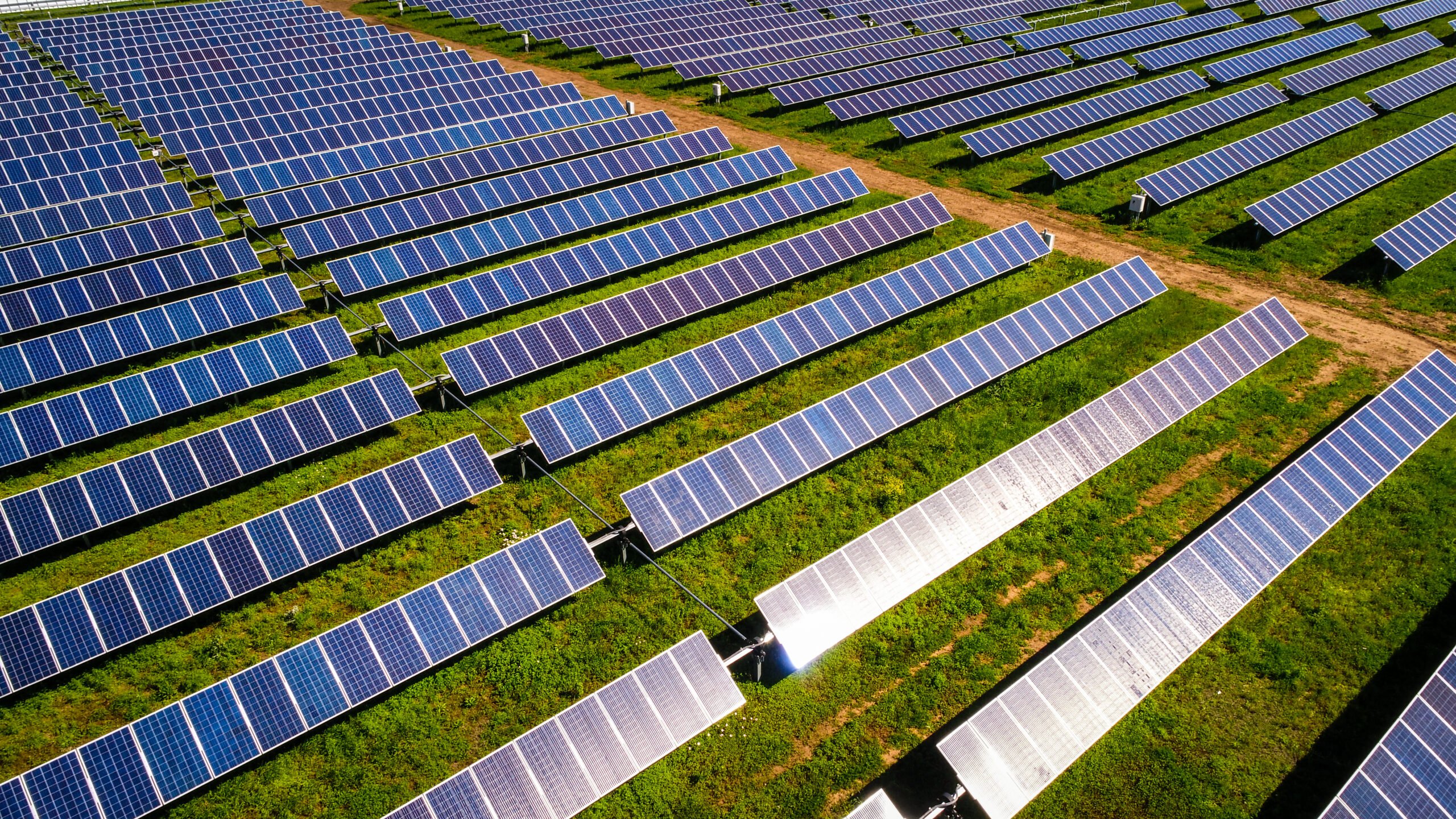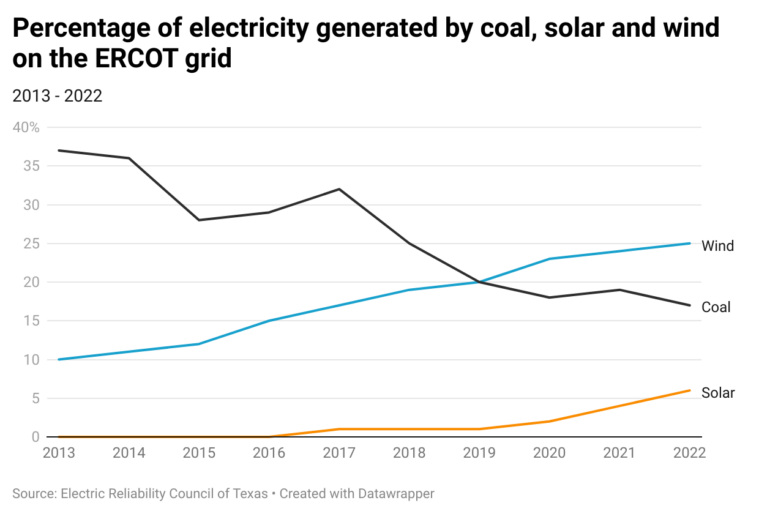
Texas Wastes Renewable Energy During June Heatwave
Solar and wind input is setting records, but the state’s inefficient grid is unable to handle the full load it could deliver in the ongoing heat wave.
This article originally appeared on Inside Climate News, a nonprofit, independent news organization that covers climate, energy and the environment. It is republished with permission. Sign up for their newsletter here.
As a massive heat dome engulfed much of Texas in 100-degree-plus weather throughout the second half of June, breaking temperature records throughout South and West Texas, renewable energy output also set new records. Renewables’ contribution to the Texas grid reached an all-time high on June 28, when 41.6 percent of the electricity on the grid was coming from wind and solar power during peak hours.
With demand for electricity also setting a record in late June, the grid operated by the Electric Reliability Council of Texas (ERCOT) has so far held up to the challenge. But summer is only beginning, and Texans are already enduring high electric bills.
John Nielsen-Gammon, the Texas state climatologist at Texas A&M University, said he expected the extreme heat to continue in the coming months, and noted that the highest temperatures in the eastern half of the state typically come in late July and August.
Texas consumes more energy than any other state and has also connected the most renewable energy resources to the grid, with 773 additional megawatts of solar projects added in June. Yet despite the record contributions from renewables, experts say the grid’s efficiency is diminished by a strained transmission infrastructure that can’t handle the full load that renewable energy can deliver.
The official notes from a June 20 ERCOT board meeting said the grid operator expects “export constraints from Panhandle, West Texas and areas of the Rio Grande Valley during high wind conditions” for the rest of the summer. That same day the meeting was taking place, Texans were being asked to conserve energy as the gap between supply and demand narrowed in the crippling heat.
“Depending on weather conditions and generation output, we could see tight grid conditions periodically this summer,” a spokesperson for the grid operator told Inside Climate News. “ERCOT will continue to monitor conditions and keep Texans informed.”
Ed Hirs, an energy economist and lecturer at the University of Houston, noted that more transmission lines and battery installations are coming to Texas in a flurry of new construction and will help stabilize the grid. But they “cannot come online fast enough” to replace retiring coal and natural gas plants that are near the end of their life spans or no longer profitable, he said.
A report released last month by the nonprofit advocacy group Americans for a Clean Energy Grid gave ERCOT a “D+” on transmission planning and development, a grade that was about average for the nation’s regional grids but well below those in the Midwest and California.
The report describes an “almost doubling of congestion” on the ERCOT grid from 2020 to 2021, and estimated the value of energy that could not reach Texas consumers due to crowded transmission lines in 2022 at $2.8 billion.
“Greater congestion equates to higher energy delivery costs and limits the opportunity for desired generation resources to add power to the grid,” the report said.
“Curtailment,” a Constraint for Renewables
Transmission lines are like the highways of an electrical grid: When energy production is high, all of the lanes fill up. When that congestion occurs, a portion of the electricity coming from renewable sources is wasted because it can’t reach businesses, households and other consumers that need it. This is called curtailment.
Elise Caplan, vice president of regulatory affairs at the American Council for Renewable Energy, said that lines running from West Texas to population centers further east were the most congested, periodically forcing wind and solar power companies to ”stop generating even though they are fully capable of doing it.”
“If you’re not generating, you’re not getting paid for that electricity,” Caplan said.
The economic burden on solar and wind industries could get worse before it gets better. In Texas, up to 5 percent of renewable generation is currently curtailed, according to a 2022 study by the Energy Systems Integration Group that used ERCOT’s own data analysis, but 20 to 28 percent could be curtailed by 2030.
Despite the shortage in transmission capacity, the share of renewables in ERCOT’s fuel mix has been steadily rising over the past decade as coal’s contribution has gone down and natural gas and nuclear have remained relatively steady.
On June 28, when wind and solar generation set a new record, Joshua Rhodes, a research scientist at the University of Texas at Austin and nonresident fellow at Columbia University, pointed out on Twitter that the record could have been even higher if not for limited transmission capacity.
Although real-time curtailment data is hard to come by, Rhodes said in an interview, he would “look for negative pricing out in West Texas” and “solar not producing as much as it’s forecasted to” as indicators that operators are curtailing renewable energy.

The Grid Operator’s Reserve Power
On June 10, ERCOT rolled out a new reserve power program known as ECRS. The grid operator pays power generators to set aside a portion of the energy they are capable of producing on standby, according to a council spokesperson. If the grid needs an extra boost to meet demand, the ECRS power can turn on in about 10 minutes and provide 2,000 megawatts. Right now, the reserve power is mostly generated on the spot by natural gas plants, but it could include more energy stored in batteries, Hirs said.
Hirs said the new standby system allowed for “massive price gouging” by power generators on June 20, when the wholesale energy cost reached about $5,000 per megawatt-hour.
As the grid operator, ERCOT pays power generators for energy, and utility providers pay into ERCOT. By paying the generators to stay offline, it saves a backup supply for emergencies. But, in a recent newspaper column, Hirs estimated that Texans paid more than $1 billion extra in electricity costs from June 16 to 20 because of the excessive prices paid for the electricity that had been held back under the new program and the overall effect of a tightening energy supply.
“That’s coming out of consumers’ pockets and going to somebody’s pockets on the generator’s side without any increase in service,” he said.
On top of the added cost of paying for extra reserve power, the inadequacy of transmission lines prevents cheaper wind and solar from bidding into the market. “We end up with essentially dirtier, more expensive power,” Rhodes said.
Separate from ECRS, ERCOT has a regular congestion pricing mechanism under which it charges utilities extra fees for the cost of turning on more power plants, mostly natural gas, to meet demand when wind or solar is being curtailed. Hirs says the grid operator views this as a way to “construct conditions conducive” to building transmission: In theory, it will be more profitable over the long run for power companies to build new transmission lines than to continue paying congestion fees.
There is some indication that it’s working, as the industry will spend $3.4 billion this year on building 470 miles of new transmission lines and upgrading 808 existing miles, according to data from ERCOT. About $11.6 billion worth of transmission projects are in the planning stages or under construction.
But Hirs said the pace of building and upgrading transmission has not kept up with the need, and not enough actors in the ERCOT market have the incentive to invest in transmission.
Connecting to Other Regions
On another track, the Biden administration’s Infrastructure Investment and Jobs Act of 2021 authorized $13 billion in federal funding for transmission projects through the Grid Resilience Innovation Partnerships program. Part of the funding will support large interregional lines to connect the nation’s disparate electrical grids.
Rhodes said that interconnecting ERCOT with the Southwest through El Paso is “an active area of research.” If the grids were connected, they could “supply power to people cheaper with fewer power plants and with a cleaner grid mix than keeping Texas islanded from the rest of the system,” he said.
One major obstacle to interconnection is political, Rhodes said: the enduring “Texas psyche of doing it on your own,” without being subject to federal regulation of interstate commerce.
Pattern Energy, a global renewable energy developer, is working on a line called Southern Spirit Transmission with the goal of allowing ERCOT to connect with the Southeast. The project could link the grids without bringing Texas’s grid operator under the regulatory authority of the Federal Electric Reliability Council because the new line will run from Mississippi to Louisiana to the Texas-Louisiana border, and a partner project using DC connections will fill the 40-mile gap to connect with the rest of ERCOT.
Adam Renz, director of project development at Pattern Energy, said the project would enable ERCOT to send power to the Southeast when the region needs access to clean energy, and allow ERCOT to “pull from Southeastern markets when the ERCOT grid is experiencing a scarcity event.”
Renz said the project has been approved by FERC and state agencies in Texas but is awaiting state approval from Louisiana and Mississippi. Construction on the $2.6 billion, 320-mile long project is set to begin in 2025, with completion projected in 2028.
As climate change drives more extreme weather, including torrid temperatures, projects such as Southern Spirit Transmission could help the region limit power interruptions.
If Texas is suffering now, the future looks far worse. “We’ve projected a further doubling of the number of 100-degree days over the next few decades,” the state climatologist, Nielsen-Gammon, noted.



